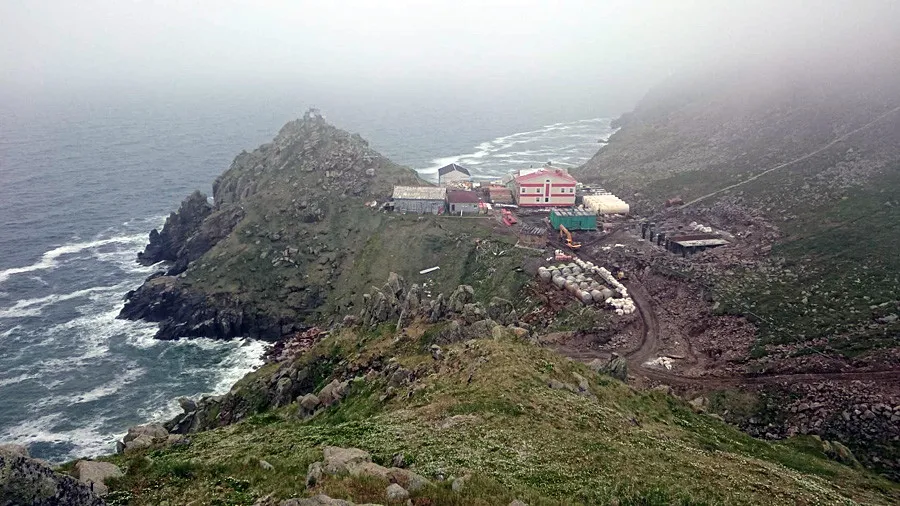Ratmanov Island — also called Big Diomede — lies in the Bering Strait between Siberia and Alaska, about 4 km west of Little Diomede in the United States. It belongs to Chukotka Autonomous Okrug, Chukotsky District. The rocky tuya-type island is roughly 29 square kilometers, with its highest point, often referenced as Krysha Peak, about 505 meters. There are no permanent civilian residents — administration is Russian, the working language is Russian, and the island hosts a border service base and a weather station. Historically, the area was used by Iñupiat and Chukchi peoples, but today access is highly restricted as a Russian border zone. No gambling exists, no civil government operates on-island, and no commercial economy functions there. Time zone is UTC+12. The island’s position just west of the International Date Line makes it the easternmost point of Russia by direction of travel and a geographical curiosity facing North America.
History
For millennia, the Diomede Islands region was part of the seasonal world of Iñupiat and Chukchi marine hunters who moved across ice and water routes, sharing family ties and trade across what is now an international boundary. The islands sit in a marine corridor used for walrus, seal, and whale hunting, and they served as waypoints in local navigation and cultural exchange.
The first recorded European contact came with Russian explorers in the 17th century. Semyon Dezhnyov is often credited with reaching or passing the area in 1648. In 1728, during his voyage to determine whether Asia and North America were connected by land, Vitus Bering sighted the islands on August 16 — St. Diomede’s Day — giving rise to their European name, the Diomede Islands. Russian cartographers refined mapping in the 1730s, embedding the islands into the expanding geography of the Russian Empire in the North Pacific.
The modern political meaning of the islands sharpened after the 1867 Alaska Purchase, when the US-Russian boundary was drawn through the narrow channel between the two islands. Big Diomede — Ratmanov Island in Russian naming, after a 19th-century Russian naval officer — remained on the Russian side; Little Diomede fell under US jurisdiction. For decades, local families still moved across the ice in winter or by boat in summer, maintaining kinship despite the new line.
World War II militarized the Bering Strait. Big Diomede hosted Soviet military facilities and later remained a sensitive outpost during the Cold War’s “Ice Curtain.” After the war, the small Indigenous community on Big Diomede was relocated to the mainland to prevent cross-border contact, while Little Diomede remained inhabited from the US side. Through the late 20th century, the islands symbolized both separation and proximity — a place where two superpowers stared across just a few kilometers of water.
In 1987, long-distance swimmer Lynne Cox made a symbolic, tightly managed swim between Little and Big Diomede, highlighting the human nearness across geopolitical distance. With the post-Soviet opening, occasional cultural and family reconnection efforts were discussed, but border and security controls remained strict. In the 21st century, Ratmanov Island continues to function as a Russian border service site and weather post, uninhabited by civilians, while expedition ships sometimes pass within view in ice-free months. The islands still mark where a date boundary and an international border nearly overlap — a rare and evocative geography shaped by sea, ice, and history.
Industry
There is no industrial activity on Ratmanov Island. No brands originate here and nothing is manufactured. Human presence is limited to the Russian border service and a meteorological station. Scientific fieldwork, when permitted, focuses on seabird colonies, marine mammals, and climate and oceanographic monitoring. The island’s only practical outputs are weather observations and occasional biological data.
Flora and fauna
The island is treeless Arctic tundra with lichens, mosses, grasses, and hardy flowering plants like saxifrages clinging to thin soils and cliffs. Seabird life is spectacular in season: thick-billed murres, kittiwakes, auklets, puffins, and cormorants nest on ledges. Pacific walrus haul out on nearby shores and ice, while ringed and bearded seals frequent surrounding waters. Bowhead, gray, and beluga whales migrate through the Bering Strait. Polar bears can appear when sea ice bridges are present. There are no known true endemics limited only to Ratmanov, but the island supports regionally important colonies. Removal of eggs, feathers, bones, plants, or marine mammal products is prohibited without permits under Russian law and international conventions.
Wars and conflicts
No battles are recorded on the island itself. Ratmanov’s significance is geopolitical — a Cold War outpost within sight of the United States.
Interesting facts
The island is often called Tomorrow Island, because it sits just across the date line from Little Diomede, sometimes dubbed Yesterday Island. In clear weather, you can see the United States from Ratmanov — and vice versa — across only a few kilometers of water. The 1987 swim between the islands became a symbol of thawing Cold War tensions. Ideas for tunnels or bridges across the Bering Strait have periodically mentioned the Diomedes as potential stepping stones, although none have materialized. Fog is so frequent in summer that entire days can pass without a glimpse of the opposite island.
Clothing
Arctic layers are essential: windproof shell, insulated mid-layers, thermal base layers, waterproof boots with good grip, hat, balaclava, and gloves. In summer, temperatures remain cold with strong wind and spray; in spring and fall, extreme wind chill and ice conditions prevail. Modesty norms are irrelevant; survival clothing takes precedence.
Tourism
Ratmanov Island is not a conventional tourist destination. It lies inside a Russian border zone, requires special FSB permits to approach or land, and is generally off-limits to civilians. The realistic way to experience it is from an expedition ship that transits the Bering Strait in late July to early September when sea ice recedes. Even then, landings are usually not offered. Scenic viewing of cliffs, bird colonies, fog banks, sea ice remnants, and the close view of Little Diomede across the water are the highlights. Time needed is measured in hours from a ship’s deck rather than days ashore. Independent travel is not viable.
Types of tourism
Expedition cruising — offshore wildlife and scenery viewing. Birdwatching — from ship with high-quality optics. Photographic voyages — seascapes, cliffs, fog, and the US-Russia juxtaposition. Scientific or journalistic visits — only under special permits and official escort.
Tourist attractions
— Cliffs of the north shore — vast bird-nesting ledges alive with murres and kittiwakes in summer
— Krysha Peak skyline — the island’s high ridge forming a stark profile over the Strait
— Walrus and seal viewing points — offshore haul-outs and ice-edge habitats seen from ships
— Viewline to Little Diomede — the rare chance to see another country across a short channel
— International Date Line proximity — a conceptual attraction marked by GPS rather than signage
— Fog seas and tide rips — dramatic meteorology and currents of the Bering Strait
Non-tourist sights
— Russian border service post — restricted military facility
— Meteorological station — operational outpost for weather observation
— Helipad and service pads — logistics infrastructure for personnel and supply
— Navigational beacons or radar equipment — part of coastal monitoring, not for public access
Why visit
To witness one of the world’s most unusual junctures: two countries, two days, and one narrow strait. The island’s raw Arctic beauty — soaring cliffs, wheeling seabirds, drifting fog, and ice-churned water — is unforgettable. Few places feel more remote yet visually close to another continent.
Safety for tourists
Primary risks are environmental: hypothermia, gale-force winds, heavy seas, tide rips, drifting ice, poor visibility, and potential presence of polar bears on ice. There is no terrorist threat profile specific to the island, but it is a sensitive military border zone where photography restrictions apply. Do not approach wildlife and do not attempt shore landings without explicit authorization. Use handrails on ship decks and wear flotation and cold-weather gear. In Russia the emergency number is 112, but offshore responses depend on ship and aviation availability.
Entry rules
A valid Russian visa is required for foreign nationals, as well as a special border zone permit to approach Ratmanov Island. Passport control and customs occur at designated ports, not on the island. Import of drones and high-powered optics may be restricted in border zones; always declare and obtain written permissions where required. Export of biological materials is prohibited.
What is discouraged or prohibited
Do not attempt unauthorized landings. Do not fly drones in a border zone. Do not photograph military sites or personnel. Do not collect flora, fauna, bones, eggs, antlers, or geological samples. Do not harass wildlife. Do not litter or discharge waste. Comply immediately with instructions from Russian authorities and your ship’s captain.
Climate
Arctic maritime. Summers are cold and foggy, typically 2–8°C, with frequent low clouds and drizzle. Winters are severe, windy, and dark, often below ‑10°C with strong wind chill and shifting sea ice. The best time to pass by is late July to early September when sea ice retreats and seas are relatively calmer, though fog is common.
Tips for travelers
Carry expedition-grade cold-weather clothing and waterproof boots. Bring binoculars and a telephoto lens with weather protection. Pack seasickness remedies. Ensure comprehensive travel insurance with medical evacuation. Do not count on any connectivity — bring offline maps, books, and spare batteries. Respect the border zone’s rules and prepare for itinerary changes due to weather.
- Sumatra
- Barack Obama: tourist places of his life and travels
- Pakistan
- Born for battle: the world’s most warlike cultures
- Grand Canyon
- Depths of the Planet: The Most Impressive Depressions of Earth
- Lofoten Islands
- Gibraltar
- Chukchi
- Bali
- Manage your travel Place
- The Louvre welcomes Renaissance masterpieces from Naples Capodimonte Museum
- Deadly Slopes: Ski Resorts with the Highest Fatality Rates
- BMW: traveling in the footsteps of a legendary brand
- Chile
- Pilaf around the world: from ancient traditions to tourist routes
- Pirate treasure hunting around the world: where to look without breaking the law
- The Crocodile Chase: An Unlikely Friendship Born in Africa
- Why Colombia is dangerous for tourists
- Colombia











